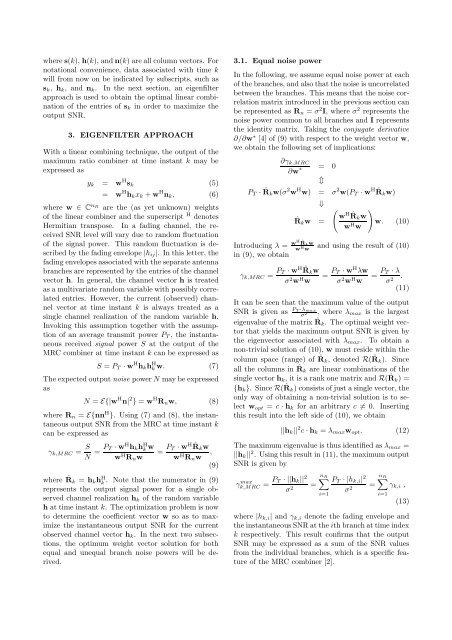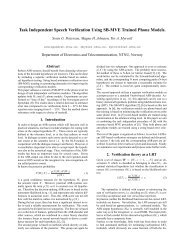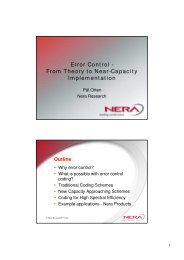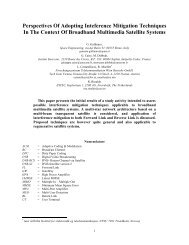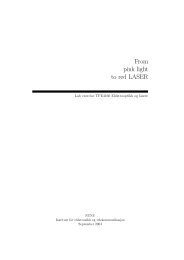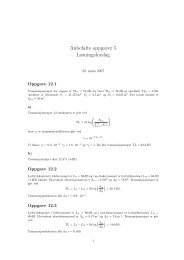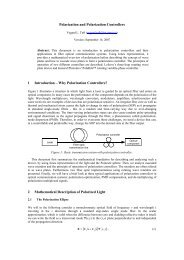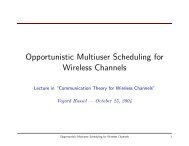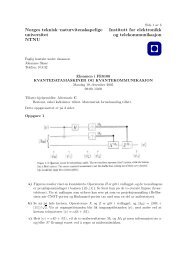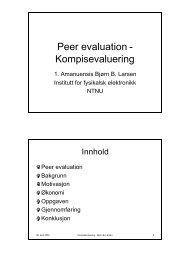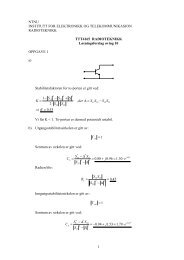THE OPTIMAL WEIGHTS OF A MAXIMUM RATIO ... - NTNU
THE OPTIMAL WEIGHTS OF A MAXIMUM RATIO ... - NTNU
THE OPTIMAL WEIGHTS OF A MAXIMUM RATIO ... - NTNU
You also want an ePaper? Increase the reach of your titles
YUMPU automatically turns print PDFs into web optimized ePapers that Google loves.
where s(k), h(k), and n(k) are all column vectors. For<br />
notational convenience, data associated with time k<br />
will from now on be indicated by subscripts, such as<br />
s k , h k ,andn k . In the next section, an eigenfilter<br />
approach is used to obtain the optimal linear combination<br />
of the entries of s k in order to maximize the<br />
output SNR.<br />
3. EIGENFILTER APPROACH<br />
With a linear combining technique, the output of the<br />
maximum ratio combiner at time instant k may be<br />
expressed as<br />
y k = w H s k (5)<br />
= w H h k x k + w H n k , (6)<br />
where w ∈ C nR are the (as yet unknown) weights<br />
of the linear combiner and the superscript H denotes<br />
Hermitian transpose. In a fading channel, the received<br />
SNR level will vary due to random fluctuation<br />
of the signal power. This random fluctuation is described<br />
by the fading envelope |h ij |. In this letter, the<br />
fading envelopes associated with the separate antenna<br />
branches are represented by the entries of the channel<br />
vector h. In general, the channel vector h is treated<br />
as a multivariate random variable with possibly correlated<br />
entries. However, the current (observed) channel<br />
vector at time instant k is always treated as a<br />
single channel realization of the random variable h.<br />
Invoking this assumption together with the assumption<br />
of an average transmit power P T ,theinstantaneous<br />
received signal power S at the output of the<br />
MRC combiner at time instant k can be expressed as<br />
S = P T · w H h k h H k w. (7)<br />
The expected output noise power N may be expressed<br />
as<br />
N = E{|w H n| 2 } = w H R n w, (8)<br />
where R n = E{nn H }. Using (7) and (8), the instantaneous<br />
output SNR from the MRC at time instant k<br />
can be expressed as<br />
γ k,MRC = S N = P T · w H h k h H k w<br />
w H R n w<br />
= P T · w H ˆR k w<br />
w H R n w , (9)<br />
where ˆR k = h k h H k<br />
. Note that the numerator in (9)<br />
represents the output signal power for a single observed<br />
channel realization h k of the random variable<br />
h at time instant k. The optimization problem is now<br />
to determine the coefficient vector w so as to maximize<br />
the instantaneous output SNR for the current<br />
observed channel vector h k . In the next two subsections,<br />
the optimum weight vector solution for both<br />
equal and unequal branch noise powers will be derived.<br />
3.1. Equal noise power<br />
In the following, we assume equal noise power at each<br />
of the branches, and also that the noise is uncorrelated<br />
between the branches. This means that the noise correlation<br />
matrix introduced in the previous section can<br />
be represented as R n = σ 2 I,whereσ 2 represents the<br />
noise power common to all branches and I represents<br />
the identity matrix. Taking the conjugate derivative<br />
∂/∂w ∗ [4] of (9) with respect to the weight vector w,<br />
we obtain the following set of implications:<br />
∂γ k,MRC<br />
∂w ∗ = 0<br />
⇕<br />
P T · ˆR k w(σ 2 w H w) = σ 2 w(P T · w H ˆRk w)<br />
⇓<br />
ˆR k w =<br />
(<br />
)<br />
w H ˆRk w<br />
w H w. (10)<br />
w<br />
Introducing λ = wH ˆRk w<br />
w H w<br />
and using the result of (10)<br />
in (9), we obtain<br />
γ k,MRC = P T · w H ˆRk w<br />
σ 2 w H w<br />
= P T · w H λw<br />
σ 2 w H w<br />
= P T · λ<br />
σ 2 .<br />
(11)<br />
It can be seen that the maximum value of the output<br />
PT ·λmax<br />
SNR is given as<br />
σ<br />
,whereλ 2<br />
max is the largest<br />
eigenvalue of the matrix ˆR k . The optimal weight vector<br />
that yields the maximum output SNR is given by<br />
the eigenvector associated with λ max . To obtain a<br />
non-trivial solution of (10), w must reside within the<br />
column space (range) of ˆR k , denoted R( ˆR k ). Since<br />
all the columns in ˆR k are linear combinations of the<br />
single vector h k , it is a rank one matrix and R( ˆR k )=<br />
{h k }.SinceR( ˆR k ) consists of just a single vector, the<br />
only way of obtaining a non-trivial solution is to select<br />
w opt = c · h k for an arbitrary c ≠ 0. Inserting<br />
this result into the left side of (10), we obtain<br />
||h k || 2 c · h k = λ max w opt . (12)<br />
The maximum eigenvalue is thus identified as λ max =<br />
||h k || 2 . Using this result in (11), the maximum output<br />
SNR is given by<br />
γ max<br />
k,MRC = P T ·||h k || 2<br />
σ 2 =<br />
n R<br />
∑<br />
i=1<br />
P T ·|h k,i | 2<br />
σ 2 =<br />
n R<br />
∑<br />
i=1<br />
γ k,i ,<br />
(13)<br />
where |h k,i | and γ k,i denote the fading envelope and<br />
the instantaneous SNR at the ith branch at time index<br />
k respectively. This result confirms that the output<br />
SNR may be expressed as a sum of the SNR values<br />
from the individual branches, which is a specific feature<br />
of the MRC combiner [2].


